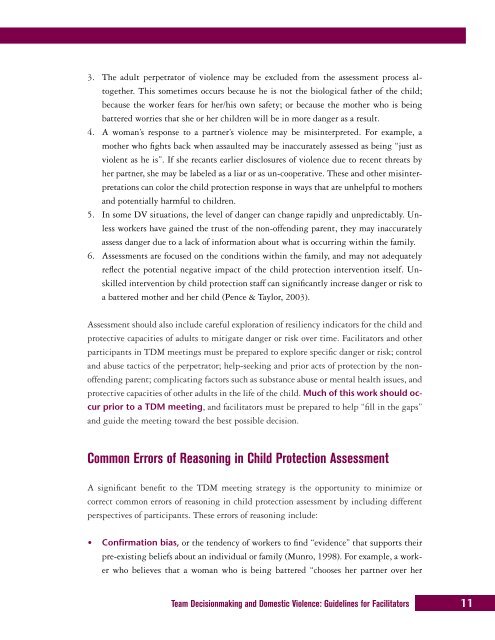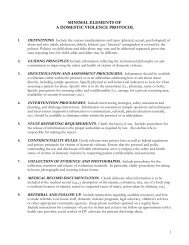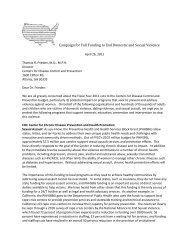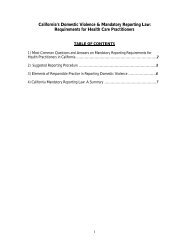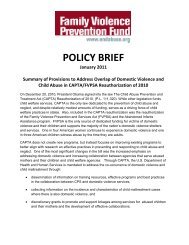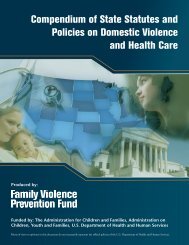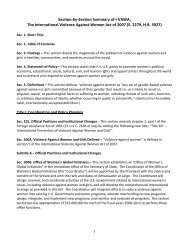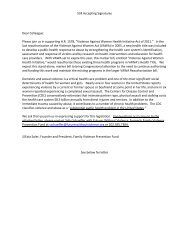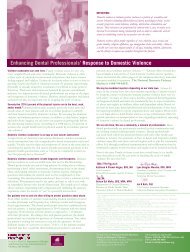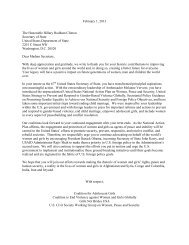Team Decisionmaking and Domestic Violence: Guidelines for ...
Team Decisionmaking and Domestic Violence: Guidelines for ...
Team Decisionmaking and Domestic Violence: Guidelines for ...
Create successful ePaper yourself
Turn your PDF publications into a flip-book with our unique Google optimized e-Paper software.
3. The adult perpetrator of violence may be excluded from the assessment process altogether.<br />
This sometimes occurs because he is not the biological father of the child;<br />
because the worker fears <strong>for</strong> her/his own safety; or because the mother who is being<br />
battered worries that she or her children will be in more danger as a result.<br />
4. A woman’s response to a partner’s violence may be misinterpreted. For example, a<br />
mother who fights back when assaulted may be inaccurately assessed as being “just as<br />
violent as he is”. If she recants earlier disclosures of violence due to recent threats by<br />
her partner, she may be labeled as a liar or as un-cooperative. These <strong>and</strong> other misinterpretations<br />
can color the child protection response in ways that are unhelpful to mothers<br />
<strong>and</strong> potentially harmful to children.<br />
5. In some DV situations, the level of danger can change rapidly <strong>and</strong> unpredictably. Unless<br />
workers have gained the trust of the non-offending parent, they may inaccurately<br />
assess danger due to a lack of in<strong>for</strong>mation about what is occurring within the family.<br />
6. Assessments are focused on the conditions within the family, <strong>and</strong> may not adequately<br />
reflect the potential negative impact of the child protection intervention itself. Unskilled<br />
intervention by child protection staff can significantly increase danger or risk to<br />
a battered mother <strong>and</strong> her child (Pence & Taylor, 2003).<br />
Assessment should also include careful exploration of resiliency indicators <strong>for</strong> the child <strong>and</strong><br />
protective capacities of adults to mitigate danger or risk over time. Facilitators <strong>and</strong> other<br />
participants in TDM meetings must be prepared to explore specific danger or risk; control<br />
<strong>and</strong> abuse tactics of the perpetrator; help-seeking <strong>and</strong> prior acts of protection by the nonoffending<br />
parent; complicating factors such as substance abuse or mental health issues, <strong>and</strong><br />
protective capacities of other adults in the life of the child. Much of this work should occur<br />
prior to a TDM meeting, <strong>and</strong> facilitators must be prepared to help “fill in the gaps”<br />
<strong>and</strong> guide the meeting toward the best possible decision.<br />
Common Errors of Reasoning in Child Protection Assessment<br />
A significant benefit to the TDM meeting strategy is the opportunity to minimize or<br />
correct common errors of reasoning in child protection assessment by including different<br />
perspectives of participants. These errors of reasoning include:<br />
• Confirmation bias, or the tendency of workers to find “evidence” that supports their<br />
pre-existing beliefs about an individual or family (Munro, 1998). For example, a worker<br />
who believes that a woman who is being battered “chooses her partner over her<br />
<strong>Team</strong> <strong>Decisionmaking</strong> <strong>and</strong> <strong>Domestic</strong> <strong>Violence</strong>: <strong>Guidelines</strong> <strong>for</strong> Facilitators 11


